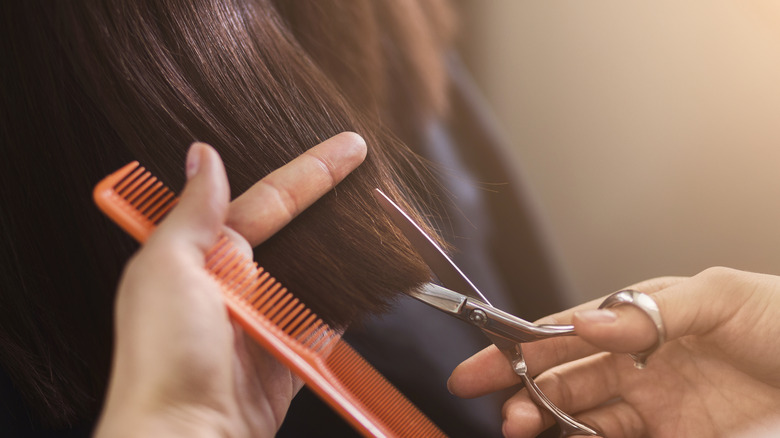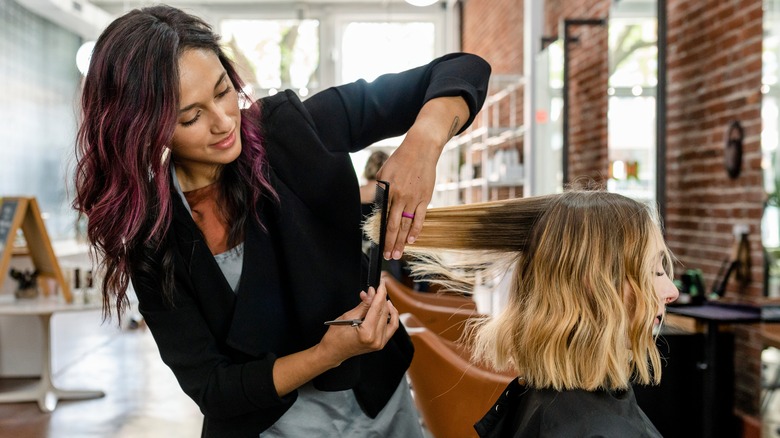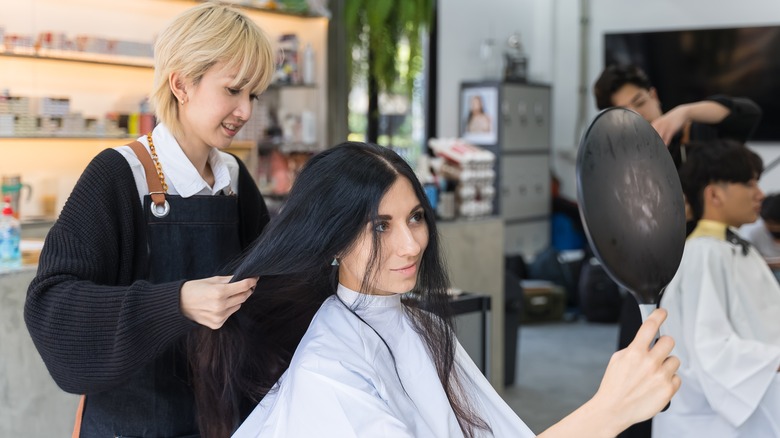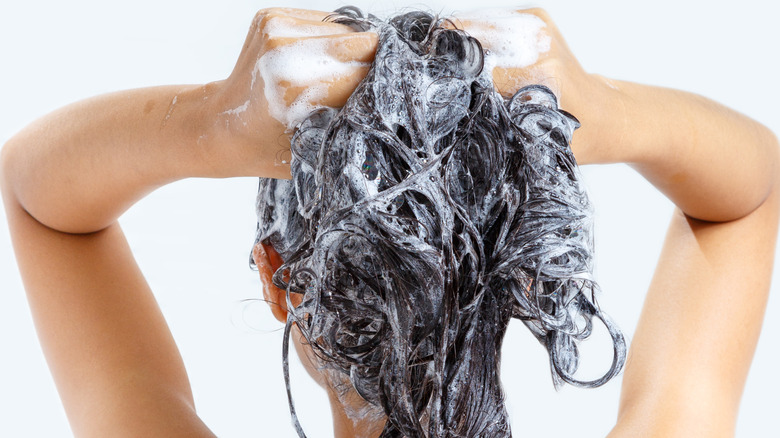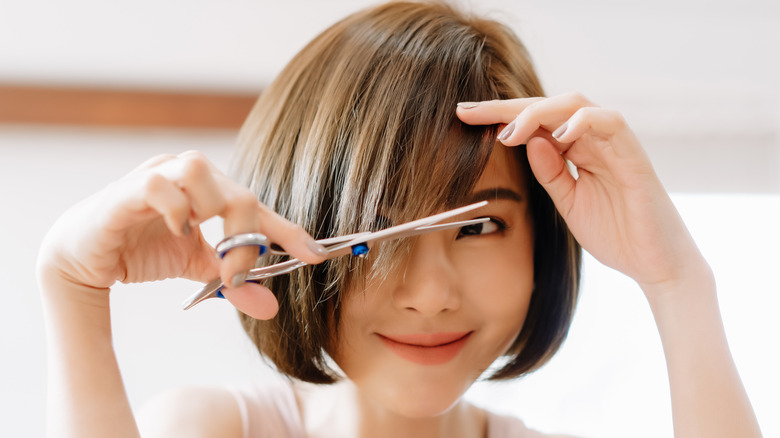What You Need To Know About Dry Hair Cutting
When you've gone to the salon for a routine haircut, you've likely had your tresses washed or at least sprayed down with water before trimming. While this is certainly a common practice, it isn't the only way you can get your hair cut. In fact, this style of cutting is referred to by professionals as a wet cut.
As L'Oréal Paris explains, many hairstylists prefer to work with wet hair if it happens to be fine, thin, or straight. This is because a wet cut can give you more precision as you trim, which is necessary if you're going for a straight, sleek style. However, there are downsides to wetting your tresses before getting a cut. One of the most commonly cited issues is that your style can look entirely different once your hair actually dries. Another problem is that you might not be going for a straight hairstyle. In fact, your hair type might be the complete opposite.
As it turns out, there are several different types of haircutting. Just because the wet cut is one of the most popular methods doesn't mean it's right for you or your hair. These days, dry hair cutting has grown in popularity, and for good reason. Here is what you need to know about this style of haircutting.
What is a dry haircut?
Dry haircutting is exactly what it sounds like: having your hair cut while it's dry, rather than wet. Typically, however, Hair.com notes that water is still part of the equation. Stylists who do dry cuts may begin trimming your tresses as soon as you arrive while your hair is still dry, or they may do so once the hair has been washed, dried, and styled. In most cases, stylists just want to handle your hair while it does not have product build-up. For this reason, your locks might require a rinse.
When you come into the salon for a dry cut, you should have confidence in your stylist. While a traditional stylist focuses on precision while working with wet hair, a stylist who is dry hair cutting is likely to take a more liberal approach. "It's not about the scissors or the comb, it's more about the hairdresser's point of view," Garrett Markenson, a celebrity hairstylist, told Mane Addicts. "With dry cuts I don't even use the comb. You really want to have your free hand feeling the density and layers. It doesn't have to do with experience or talent. It's not about one being wrong and one being right."
The benefits of getting a dry haircut
There are many benefits to dry hair cutting, and they aren't limited to your hair type or texture. "I like to cut on dry hair when my client wants to play up their natural texture and see the hair transformation up front, rather than it being a surprise when it dries," hairstylist Kelly Carbajal told Ipsy.
However, there's no question that dry haircuts are especially helpful when working with curly hair. This is because curly and wavy hair types often have specific curl patterns. Cutting these tresses while wet runs the risk of creating an uneven appearance once they've dried. "With curly hair, I'm able to be more precise and work with shapes better than when the hair is cut wet," Carbajal told Ipsy. "It allows me to see how the hair moves in its natural state."
Dry hair cutting is also beneficial for those who have extensive damage. A stylist who dry cuts your tresses can focus on getting rid of the split ends, for example, without touching your healthy strands. "If someone has fine or damaged hair, I'm able to see what [can stay] and what needs to go," Carbajal explained to Ipsy.
The potential downsides of dry hair cutting
There are certainly notable advantages to dry hair cutting, but there are some notable drawbacks as well. Before you run to the salon and ask for this type of cut, it's worth taking a look at the end goal in regard to your hairstyle.
Dry haircutting is often a technique used by stylists who are working with clients who aren't focused on precision. For example, if you're looking for an A-line cut or a bob with distinct lines, this may not be best for you. Similarly, if you're looking for a sleek, straight style, your hairdresser will likely recommend wetting your tresses first, as this will allow them to work on your strands with more precision.
It's also important to ensure that you'll be working with a stylist who knows how to execute a dry cut if you're set on trying this technique. Going to a stylist who has experience with dry hair cutting can give you peace of mind, knowing you'll get the style you envisioned. Furthermore, you'll be able to avoid the potential for haircut disasters. By going to a stylist who does not have the background experience, you not only run the risk of getting a bad haircut but causing damage to your locks.
How to prep for your first dry haircut
Once you've decided that a dry haircut is right for you, you can start your prep work before hitting the salon. While homework doesn't sound exciting, taking a few steps before your tresses receive a trim can ensure the best possible outcome. You can help your hairdresser out by coming in with photos of the style you want before they even touch their scissors. Do some browsing on social media or flip through a few magazines to nail down the exact look you want. Together, you can discuss what will work best for your specific hair type and texture.
Before you head to the salon, you don't necessarily need to do any prep to your tresses in terms of washing or styling — it may even be more beneficial for your hairdresser to see your hair in its natural state to achieve the best results. However, it's important to be honest with your stylist about your haircare routine. Even if you're embarrassed by how often (or little) you hydrate your locks, for example, telling your hairdresser can help. With this knowledge, your stylist can give you beneficial tips for taking care of your hair post-dry cut.
Tips for keeping your hair healthy in between cuts
Once you've received your dry haircut and you're in love, you'll want to begin taking care of your tresses to maintain your new style. In addition to adopting any tips your hairdresser gave you, there are a few other beneficial steps you can add to your haircare routine.
Protecting your locks from heat during blow drying is a must. By applying a heat protectant beforehand, you can seal in moisture and avoid damage. Generally speaking, hydration should be a priority when it comes to your tresses. Adding products, such as leave-in conditioner, to your haircare routine can maintain moisture, combat frizz, and reduce split ends. That being said, it's important to use products that are formulated for your specific hair type and texture to see the best results. Other factors that may impact your choice of products include whether your hair has been chemically treated, bleached, or dyed.
Once you understand your hair type and texture, you can begin to focus on any ongoing issues, such as frizz or brittleness. From here, you can identify potentially beneficial products, such as hair masks, to keep your tresses healthy in between dry cuts.
Is it possible to dry cut your own hair at home?
There is no hard rule that says you need to go to a salon to dry-cut your hair. In fact, many people prefer to cut their own hair, especially if they tend to only require trims. If you feel comfortable enough taking scissors to your tresses, there are a couple of tips you can use to reduce the risk of a bad cut.
To start, take it slow. Going snip-by-snip is a helpful practice, especially if you have never cut your own hair. Dry hair cutting is ideal for those giving themselves a trim, as wet hair increases the risk of accidentally cutting tresses too short. Think twice about the scissors you intend to use on your locks as well (hint: household scissors are not appropriate in this situation). Ideally, professional shears should be used, if only for their sharpness, as dull scissors can damage the ends of your hair.
Finally, think vertically once you begin the cutting process, rather than horizontally. Cutting vertically can help you avoid creating a hairstyle that looks too blunt. If you begin to question your skills at any point during the process, drop the scissors and head to your salon.
